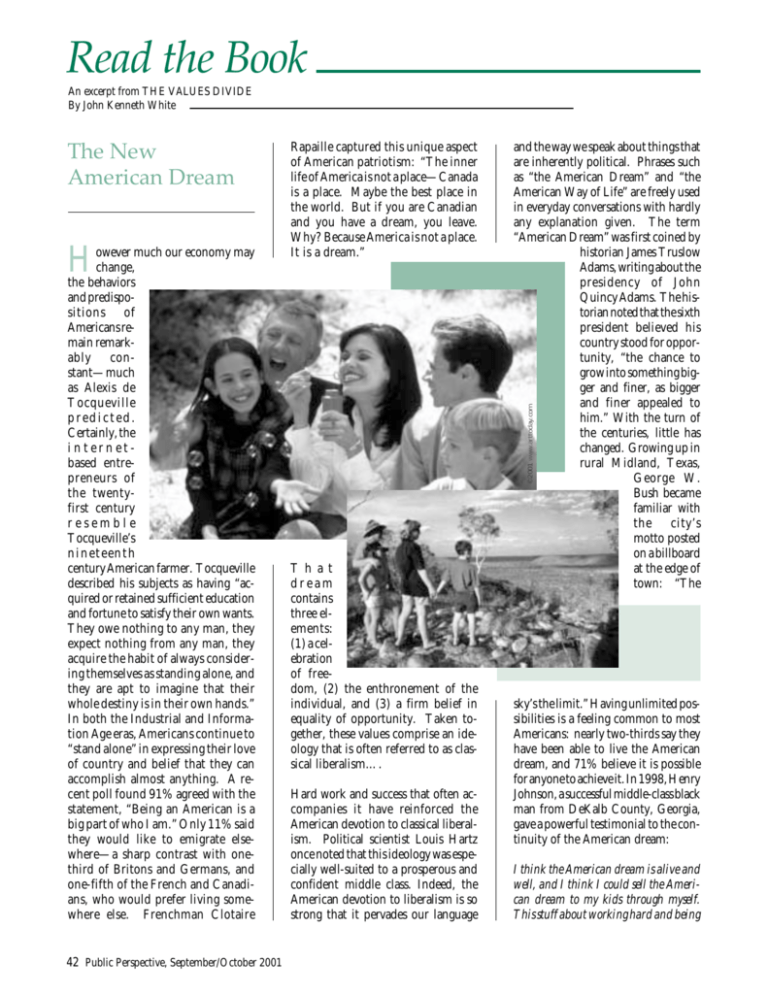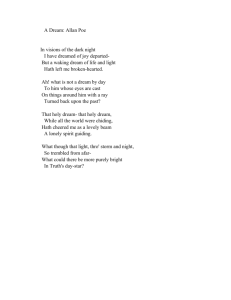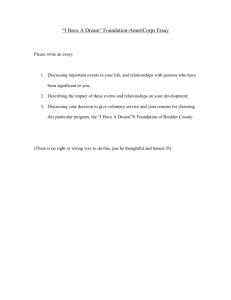
Read the Book
An excerpt from THE VALUES DIVIDE
By John Kenneth White
H
owever much our economy may
change,
the behaviors
and predispositions
of
Americans remain remarkably
constant—much
as Alexis de
Tocqueville
predicted.
Certainly, the
internetbased entrepreneurs of
the twentyfirst century
resemble
Tocqueville’s
nineteenth
century American farmer. Tocqueville
described his subjects as having “acquired or retained sufficient education
and fortune to satisfy their own wants.
They owe nothing to any man, they
expect nothing from any man, they
acquire the habit of always considering themselves as standing alone, and
they are apt to imagine that their
whole destiny is in their own hands.”
In both the Industrial and Information Age eras, Americans continue to
“stand alone” in expressing their love
of country and belief that they can
accomplish almost anything. A recent poll found 91% agreed with the
statement, “Being an American is a
big part of who I am.” Only 11% said
they would like to emigrate elsewhere—a sharp contrast with onethird of Britons and Germans, and
one-fifth of the French and Canadians, who would prefer living somewhere else. Frenchman Clotaire
42 Public Perspective, September/October 2001
Rapaille captured this unique aspect
of American patriotism: “The inner
life of America is not a place—Canada
is a place. Maybe the best place in
the world. But if you are Canadian
and you have a dream, you leave.
Why? Because America is not a place.
It is a dream.”
and the way we speak about things that
are inherently political. Phrases such
as “the American Dream” and “the
American Way of Life” are freely used
in everyday conversations with hardly
any explanation given. The term
“American Dream” was first coined by
historian James Truslow
Adams, writing about the
presidency of John
Quincy Adams. The historian noted that the sixth
president believed his
country stood for opportunity, “the chance to
grow into something bigger and finer, as bigger
and finer appealed to
him.” With the turn of
the centuries, little has
changed. Growing up in
rural Midland, Texas,
George W.
Bush became
familiar with
the
city’s
motto posted
on a billboard
at the edge of
town: “The
©2001 www.arttoday.com
The New
American Dream
T h a t
dream
contains
three elements:
(1) a celebration
of freedom, (2) the enthronement of the
individual, and (3) a firm belief in
equality of opportunity. Taken together, these values comprise an ideology that is often referred to as classical liberalism….
Hard work and success that often accompanies it have reinforced the
American devotion to classical liberalism. Political scientist Louis Hartz
once noted that this ideology was especially well-suited to a prosperous and
confident middle class. Indeed, the
American devotion to liberalism is so
strong that it pervades our language
sky’s the limit.” Having unlimited possibilities is a feeling common to most
Americans: nearly two-thirds say they
have been able to live the American
dream, and 71% believe it is possible
for anyone to achieve it. In 1998, Henry
Johnson, a successful middle-class black
man from DeKalb County, Georgia,
gave a powerful testimonial to the continuity of the American dream:
I think the American dream is alive and
well, and I think I could sell the American dream to my kids through myself.
This stuff about working hard and being
morally sound and the more you give, the
more you receive and things will come to
you—I think those are all things that are
not fantasies. Those things can happen
and, through my own expe-
to break up Microsoft. This, too, has
much in common with the past. A
1940 Fortune magazine survey found
74% rejected the idea that there “should
be a law limiting the amount
of money an individual is allowed to earn in a
year.” Throughout history, the American dream has
served as a reference point for achieving financial security. During the “me”
decade of the 1980s, for example, most
saw the American dream in these terms:
61% said it was doing better than one’s
parents; 79% spoke of home ownership; 58% said it was starting your own
business; 52% said it was rising from
being a clerk to company president.
“‘America is not a place. It is a dream.’”
riences, those things have happened....
Like I said, I believe in the American
dream, I do.
Sitting nearby, Johnson’s wife told the
interviewer, “Wow, that was good;
quote him on that.”
Today, when asked to define the American dream, 25% say it is having a good
family life and taking care of one’s
family; 20% talk about the freedom to
choose; 19% mention having financial
stability and making a good living;
16% respond that it is achieving success and reaching one’s goals; 16% say
it is enjoying life and achieving happiness; 11% cite home ownership; and
10% claim it is having a good job and
being happy with your work. Certainly, having financial wealth is an
important part of the American dream,
and in the “dot com” Information Age,
Bill Gates is its best-known symbol.
Gates has become a modern-day
Horatio Alger figure who is almost
universally admired for his ingenuity
and dedication to hard work. With an
estimated net worth of $90 billion,
Gates consistently appears on Gallup’s
“most admired man” list. Two-thirds
of those polled view him favorably,
and many see him as the premier business leader of the twentieth century.
An astounding one-third name Gates
as the greatest business figure of the
last thousand years.
As these numbers indicate, Gates’s success is generally celebrated—despite
recent attempts by the US government
In the 1990s, there was a shift away
from an American dream centered in
materialism toward one founded on
spiritual and family values—including
the achievement of love and attaching
a broader meaning to one’s existence.
A recent survey among young people
aged twenty to thirty-nine found twothirds said their number-one personal
goal in
life was to
do whatever they
wanted.
One-fifth
hoped to
work on
behalf of
society, and only 6% said they wanted
to get rich. Aware of these new realities, Madison Avenue’s Citibank recently dropped its “Why Aren’t You a
Millionaire Yet?” television slogan in
favor of an advertisement celebrating
life’s simpler pleasures. The bank now
tells prospective clients that the surest
way to “get rich quick” is to play with
your kids. So swift is the transformation that the world’s most powerful
financial institution now uses the tag
line, “There’s more to life than money.”
Likewise, the memorable 1999 Discover brokerage commercial featuring
a scruffy tow-truck driver whose daytrading talents earned him enough
money to buy his own island is banished from the airwaves. Former Labor Secretary Robert Reich writes that
in the 1990s financial institutions enticed customers saying, “Come with us
and make a bundle.” “Now,” he says,
“people are thinking about saving a
little bit more, slowing down, getting a
life.” Pollster John Zogby finds such a
redefinition of the American dream to
include more love and less materialism
appeals to lower income groups who
believe that material wealth is elusive.
Marge Magner, head of Citigroup’s
consumer businesses, says of her
company’s advertisements: “Our target customer is not the person who
thinks they’re going to become a millionaire with the next IPO.” Yet, even
those who are well-to-do now ask themselves, “Is this all there is?”
In asking and answering this question,
an increasing number of Americans
are making significant lifestyle
changes.... While Americans are more
prosperous than ever before, most agree
that prosperity
does not bring
them happiness
(many think they
are happier than
Bill Gates, for example). Thus,
they are willing
to
question
prosperity’s
value in an age that seems lacking in
spiritual values. Put another way, the
table is full but there remains a feeling
of emptiness after the meal.
“Even those who are wellto-do now ask themselves,
‘Is this all there is?’”
From The Values Divide: American Politics
and Culture in Transition. Copyright
©2002 by Chatham House Publishers. All
rights reserved.
Public Perspective, September/October 2001 43







